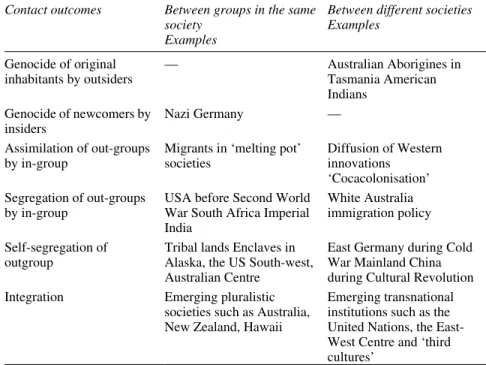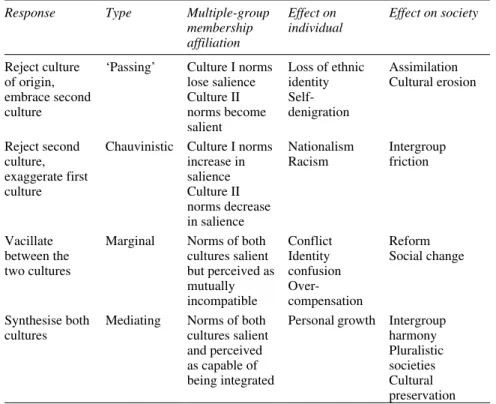The Psychology of Culture Shock will be an essential reference and textbook for courses in psychology, sociology and business training. A special strength of this book is that it treats culture shock as an active process of dealing with change rather than a harmful event.
The psychology of intercultural contact
In this section we have tried to identify the common and unique aspects of culture contact literature in different groups. Finally, in Chapter 12 we conclude with a brief review and assessment of the field, a comparison of past and present research, and a cautious forecast for the future.
Introduction and overview: Setting the scene
There are large cross-cultural differences in the pattern of the mutual relationship between the individual and the group. Some of the implications of these differences will be discussed in more detail in later sections of this book.
Intercultural contact: Processes and outcomes
Much research has been done on the psychological effects of the four different decisions to contact pressure. Some of the earliest work on intercultural contact arose in the context of research on migration and mental health.
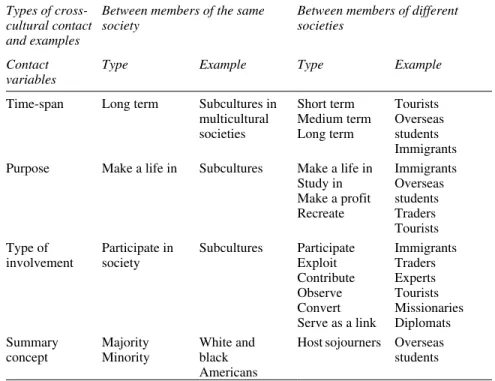
Theoretical approaches to culture shock
Cultural learning, stress and coping, and social identification theories represent broad and comprehensive conceptual frameworks for the study of intercultural contact and intercultural adaptation. Life changes, including personal loss, are a core component of the stress and coping approach to cross-cultural transition and adjustment.
Culture learning
Physical contact between members of the opposite sex in public is rare and considered offensive (Feghali, 1997). In another aspect of the same study, pedestrian walking speed was measured in the same cities. Conventions about punctuality are just one example of the many social rules that cross-cultural travelers must consider.
Often people become aware of the existence of a certain rule only after they have broken it. This is achieved by including on the card titles, degrees, position in the company and other details that accurately determine the person's social position. On the other hand, they may become socially and economically marginalized if they resist adopting some of the more utilitarian practices of their new society.
It should also be noted that code switching is a special case of the speech adaptation process reviewed earlier in the discussion on the CAT model of intercultural communication. The results of the study clearly showed that social difficulty was a function of cultural distance, i.e.
Stress, coping and adjustment
Although it is therefore clear that there is a reliable, moderate positive correlation between life changes and psychological symptoms, these changes are only responsible for a small part (usually less than 10 percent) of the difference in the psychological well-being of residents and refugees. The hypothesis requires more systematic investigation, and comparative data from East Asian and Euro-American students who have sojourned to more individualistic countries (eg, the United States, Australia) are needed. Authoritarianism, rigidity and ethnocentrism, for example, are hypothesized to hinder psychological adjustment during cross-cultural transition (Locke and Feinsod, 1982) while extraversion and sensitivity, the embodiment of the.
Some researchers have emphasized the importance of the family and focused on marital relationships as the primary source of social support. For example, Naidoo (1985) reported that immigrant Asian women in Canada were significantly less stressed when they had supportive husbands, and Stone Feinstein and Ward (1990) found that the quality of the marital relationship was one of the most important predictors psychological health. - be American women residing in Singapore. Indeed, the mainstream psychological literature has long recognized the complementarity of stress and coping and social skills analyzes of human behavior.
The social, political and economic characteristics of the society of residence can also affect psychological well-being. The stress and coping framework incorporates both these general and specific features of cross-cultural transition coping in the analysis and interpretation of the adjustment process.
Social identification theories
Most early studies of immigrants relied on a rather simplistic, one-dimensional, one-dimensional model of acculturation and identity (Figure 5.1). Some instruments allow independent assessment of home and host culture identity and the combination of the two scales for categorical assignment. Migrant groups, like other minorities, are often subjected to negative stereotypes and prejudiced attitudes from members of the majority.
Given the generally underprivileged status of migrant groups and the magnitude of the changes associated with intercultural transition, it is not surprising that Tajfel's Social Identity Theory has been one of the most widely used conceptual frameworks for examining identity and intergroup relations in immigrants. refugees and aliens (see Moghaddam, 1998; Phinney, 1990). The greatest increase in appreciation was found among older, non-Hispanic and lower SES migrants, as they came closer to members of the host culture. Immigrants, foreign nationals and refugees must deal with issues relating both to the preservation of cultural heritage and to contacts with members of the host society.
Most importantly, however, those who adopted collectivist strategies had a stronger belief in the justice and fairness of the Canadian system. Here we address three questions about identity and intergroup relations, and how the multicultural assumption challenges aspects of Social Identity Theory and features of the popular models of acculturation.

Varieties of culture travellers
In the first edition of this book, these separate outcome categories were not explicitly separated, although they were implied in most treatments. In the following chapters, we will interpret the literature more thoughtfully in terms of the ABC conceptual framework. Since the publication of the first edition of this book, many things have changed in the world.
The most famous Western schemes were the Fulbright program in the United States, the East-West Center in Hawaii, and the Colombo Plan funded by Australia. Where in the past the stay of most overseas students was financially subsidized by the taxpayers of the host countries, the situation is now almost completely reversed. Current contact research reflects this change in the status of the international student, and some of this will be reviewed in this section of the book.
In immigration and refugee movement, there have also been some major, significant developments in the last 20 or 30 years. In the following chapters, we will describe each of the main categories of cultural travelers (tourists, international students, international business people, immigrants and refugees).
Tourists
The effect of the travel experience on tourists is the subject of extensive debate. And a recent review of the research literature found very little evidence for the proposition that tourism promotes peace (Litvin, 1998). In many ways, the backpacker phenomenon appears to be a modern version of the 'Grand Tour'.
This converges with the 'niche' market data to suggest that the proportion of tourists who have significant cross-cultural contact with members of the host community is relatively small. One can be quite clear about the effects of tourism on the cultures, communities, cities, regions and individuals of the countries visited. There is also an obvious pro-development bias in much of the writing in this area.
Individual differences between members of the local population, such as age, occupation, location and socio-economic status, are also important. Travelers in many of the tourism categories have very few non-trivial encounters with host nationals.
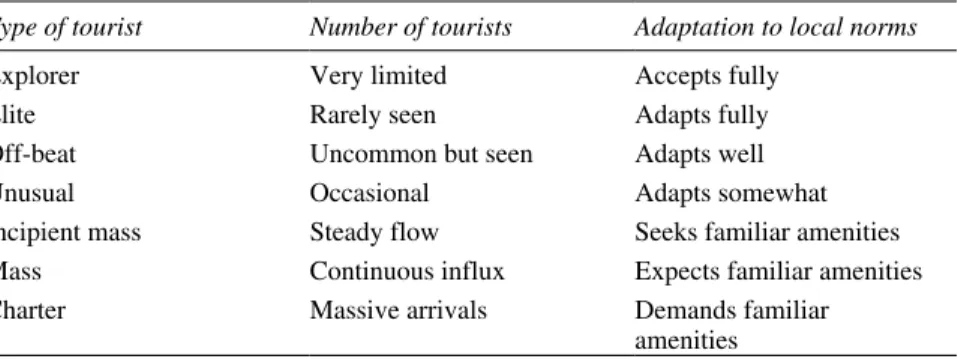
Sojourners: International students
Finally, research on foreign nationals, especially studies among international students, also includes research on the re-entry process. Furnham and Bochner (1982) found that close ties to Britons accounted for only 18 percent of foreign students' friendships in Britain, compared to 39 percent of foreign students and 38 percent of other foreign students. Bond argued that the stereotypes also reflect a "grain of truth" because they accurately reflect significant differences in the behavioral traits of the two groups.
Fortunately, a small number of researchers have attempted to develop standardized measures of the difficulties experienced by international students (eg Sandhu and Asrabadi, 1994). Overall, the vast majority of Asian students in Liberman's study approved of the critical thinking skills facilitated in the American system. Ying and Liese's study that examined the impact of pre-departure variables on the post-arrival adjustment of 172 Taiwanese students in the United States is an example of the first type of longitudinal investigation.
A hierarchical regression analysis revealed that level of predeparture depression was the strongest predictor of postarrival adjustment, and it accounted for 16 percent of the variance in international students' depressive symptoms. Studies of the affective component of cultural contact have been related to the description and prediction of the psychological adjustment of foreign students.
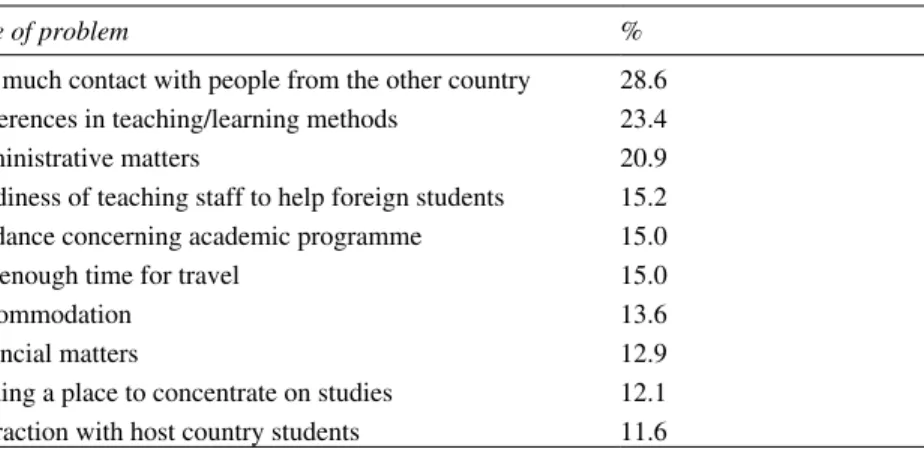
Sojourners: International business people
A strong finding in the culture-contact literature is that the adjustment and coping problems of sojourners increase with the distance between their culture of origin and that of the host society. The authors interpret their findings in terms of the degree of cultural similarity between the individuals interviewed. However, job performance varied as a function of the interaction between the participants' culture and the extent to which they were empowered.
And, according to the authors, most organizations do not interview the candidate's spouse or family. These can be further classified in a 2×2 framework based on the phase of the residence cycle (pre-departure period or overseas assignment) and the characteristics of the expatriates and their organizations. But this is not what Selmer and Shiu (1999) found in their study of the adjustment of immigrant business managers from Hong Kong to the PRC.
The results showed that, as predicted, perceived ethnocentrism was negatively related to job adjustment and commitment to the local branch of the organization. There is a growing interest in studying the role of mentoring in expatriate adjustment during the three phases of the stay: pre-departure.
